- Home
- About
- Map
- Trips
- Bringing Boat West
- Migration West
- Solo Motorcycle Ride
- Final Family XC Trip
- Colorado Rockies
- Graduates' XC Trip
- Yosemite & Nevada
- Colorado & Utah
- Best of Utah
- Southern Loop
- Pacific Northwest
- Northern Loop
- Los Angeles to NYC
- East Coast Trips
- Martha's Vineyard
- 1 Week in Quebec
- Southeast Coast
- NH Backpacking
- Martha's Vineyard
- Canadian Maritimes
- Ocracoke Island
- Edisto Island
- First Landing '02
- Hunting Island '02
- Stowe in Winter
- Hunting Island '01
- Lake Placid
- Chesapeake
- Provincetown
- Hunting Island '00
- Acadia in Winter
- Boston Suburbs
- Niagara Falls
- First Landing '99
- Cape Hatteras
- West Coast Trips
- Burning Man
- Utah Off-Roading
- Maui
- Mojave 4WD Course
- Colorado River Rafting
- Bishop & Death Valley
- Kauai
- Yosemite Fall
- Utah Off-Road
- Lost Coast
- Yosemite Valley
- Arizona and New Mexico
- Pescadero & Capitola
- Bishop & Death Valley
- San Diego, Anza Borrego, Joshua Tree
- Carmel
- Death Valley in Fall
- Yosemite in the Fall
- Pacific Northwest
- Utah Off-Roading
- Southern CA Deserts
- Yosemite & Covid
- Lake Powell Covid
- Eastern Sierra & Covid
- Bishop & Death Valley
- Central & SE Oregon
- Mojave Road
- Eastern Sierra
- Trinity Alps
- Tuolumne Meadows
- Lake Powell Boating
- Eastern Sierra
- Yosemite Winter
- Hawaii
- 4WD Eastern Sierra
- 4WD Death Valley +
- Southern CA Deserts
- Christmas in Tahoe
- Yosemite & Pinnacles
- Totality
- Yosemite & Sierra
- Yosemite Christmas
- Yosemite, San Diego
- Yosemite & North CA
- Seattle to Sierra
- Southwest Deserts
- Yosemite & Sierra
- Pacific Northwest
- Yosemite & South CA
- Pacific Northwest
- Northern California
- Southern Alaska
- Vancouver Island
- International Trips
- Index
- Tips
- Books
- Photos/Videos
- Search
- Contact
John Day Fossil Beds National Monument - Sheep Rock Unit, OR
Monday, September 9, 2019 - 10:15pm by Lolo
45 miles and 1 hour from our last stop - 1 night stay
Travelogue
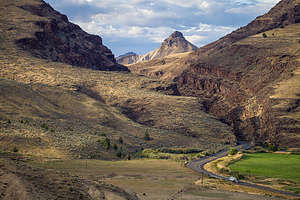 The road to Sheep RockThe next morning we drove east on Highway 26 for about 50 miles to the second of the three units in John Day Fossil Beds National Monument - the Sheep Rock Unit. This is the unit that gives the “fossil” part of Fossil Beds its name, as it has been and still is the site of massive amount of fossil discoveries, dating from over 30 million years ago.
The road to Sheep RockThe next morning we drove east on Highway 26 for about 50 miles to the second of the three units in John Day Fossil Beds National Monument - the Sheep Rock Unit. This is the unit that gives the “fossil” part of Fossil Beds its name, as it has been and still is the site of massive amount of fossil discoveries, dating from over 30 million years ago.
Fossils were first discovered in this area in 1862, when Union cavalry troops guarding wagons of gold noticed fossils in the hills. They collected what they could and took them to Thomas Condon, a Congregationalist minister and avid geologist. Recognizing the importance of these fossils, Condon returned often to the area, which is now the Blue Basin of the Sheep Rock Unit, where he found an abundance of ancient life preserved in the hills. Soon word got out and paleontologists from around the country came to Oregon to search on their own. Researchers are still studying this area and new discoveries are being made to this day.
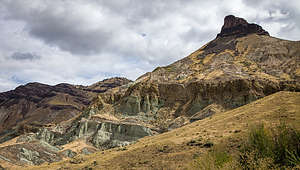 Sheep RockToday, at the Sheep Rock Visitor Center there is a museum with a working laboratory and collections room with over 60,000 fossil specimens. It is appropriately called the Thomas Condon Paleontology Museum as he was the one who first recognized the significance of the fossil beds here and did the first scientific collection and study of the specimens.
Sheep RockToday, at the Sheep Rock Visitor Center there is a museum with a working laboratory and collections room with over 60,000 fossil specimens. It is appropriately called the Thomas Condon Paleontology Museum as he was the one who first recognized the significance of the fossil beds here and did the first scientific collection and study of the specimens.
Before driving into Sheep Rock, we decided to check out the Bureau of Land Management Mascall Formation Overlook, just a little past the entrance to the park up on Antone Road. Besides the great view of the actual rock formation known as Sheep Rock, we noted the picnic table and restrooms as a possible spot to cook dinner later. No camping is allowed in the parking lot, but since camping is generally permitted pretty much anywhere on BLM land, we drove a little further along a gravel road and found a perfect spot on a ridge with great views. Hopefully, it would still be available when we returned in the evening.
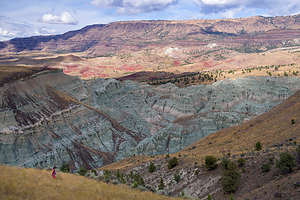 Hike along the Blue Basin Overlook TrailWe started our visit at John Day at the visitor center and strolled through the Thomas Condon Paleontology Museum where there were informative exhibits, fossil displays, and a laboratory.
Hike along the Blue Basin Overlook TrailWe started our visit at John Day at the visitor center and strolled through the Thomas Condon Paleontology Museum where there were informative exhibits, fossil displays, and a laboratory.
From the Visitor Center, we took a short walk to an overlook of the park’s namesake Sheep Rock, which rises 1,100 feet above the John Day River. Unlike the colorful reds and yellows we saw in the Painted Hill Units, Sheep Rock and the other formations in this unit are colored in shades of greens and blues, caused by the chemical weathering of a mineral called celadonite. Atop the bands of blues and greens, Sheep Rock is topped by a pointed basalt peak.
We continued driving north through the park along the John Day River, stopping to cook a mid-day lunch at the Blue Basin Trailhead. This section of the road drives along the boundary of the park, so it was interesting to see the stark rock formations juxtaposed by ranches with irrigated green fields.
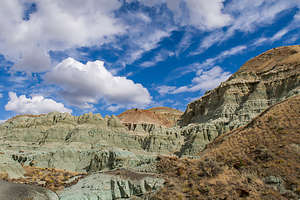 Island in Time Trail along the canyon floor of the Blue BasinAfter lunch we hiked the Blue Basin Overlook Trail, a moderately strenuous hike that rises 760 feet to an overlook of the stunning Blue Basin and the steep canyons cut by the John Day River below. It was an extremely rewarding hike.
Island in Time Trail along the canyon floor of the Blue BasinAfter lunch we hiked the Blue Basin Overlook Trail, a moderately strenuous hike that rises 760 feet to an overlook of the stunning Blue Basin and the steep canyons cut by the John Day River below. It was an extremely rewarding hike.
Rather than return directly to the parking lot, we turned onto the Island in Time Trail which followed the canyon floor through the blue-green badlands we had just looked down on. Along the way there were several replicas of fossils found along this area.
Continuing north we passed Cathedral Rock, another beautiful formation with multi-colored layers of blues and greens. Unfortunately, it was in the shade by this time of day. The challenge for photography in a place like John Day is being in the right place at the right time.
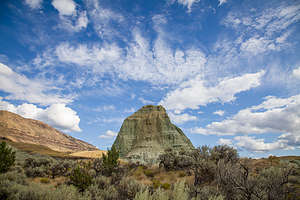 Another blue-green rock formation on Flood of Fire TrailNext we came to the Foree Trailhead where there were two short hikes to colorful rock formations. Unfortunately, they were darkened by clouds. However, we were patient and waited for a bit of sun to paint them in light.
Another blue-green rock formation on Flood of Fire TrailNext we came to the Foree Trailhead where there were two short hikes to colorful rock formations. Unfortunately, they were darkened by clouds. However, we were patient and waited for a bit of sun to paint them in light.
This was the end of the road, so we retraced our way back through the park, stopping once more at the Sheep Rock Overlook to capture it in the glow of pre-sunset light.
What a great park, and like the Painted Hill Unit, so easy to conquer in a day - except if you are a paleontologist spending years digging for fossils.
We made our way back to our BLM campsite on the hill and were delighted to find it still unoccupied. The views over the ridge were lovely - much better than our campsite last night.
Description
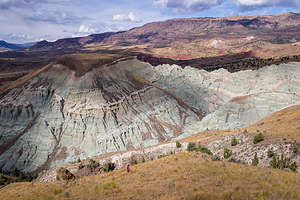 Hike along the Blue Basin Overlook TrailJohn Day Fossil Beds National Monument is divided into three units: Clarno, Painted Hills, and Sheeps Rock.
Hike along the Blue Basin Overlook TrailJohn Day Fossil Beds National Monument is divided into three units: Clarno, Painted Hills, and Sheeps Rock.
The Sheep Rock Unit, which is the subject of this stop, is the largest of the three divisions, and is located about 50 miles east of the Painted Hills Unit, on Highway 19, between the towns of Kimberly and Dayville, Oregon.
This is the unit that gives Fossil Beds its name, as it is the site of a massive amount of fossil discoveries dating from over 30 million years ago. The presence of fossils was first discovered in this area in 1862, when Union cavalry troops guarding wagons of gold near Canyon City noticed fossils in the hills. They collected what they could and took them to Thomas Condon, a Congregationalist minister and avid geologist. Recognizing the importance of these fossils, Condon returned often to the area which is now the Blue Basin of the Sheep Rock Unit, where he found an abundance of ancient life preserved in the hills. Soon word got out and paleontologists from around the country came to Oregon to search on their own. Researchers are still studying this area and new discoveries are being made to this day.
Today, the Thomas Condon Paleontology and Visitor Center has a working laboratory and collections room with over 60,000 fossil specimens. In the museum gallery, you can walk through nearly 50 million years of the Age of Mammals.
In addition to this fascinating museum, there are scenic drives and hikes to explore the prehistoric past of the area as well as the colorful rock formations.
Some hikes include:
- Blue Basin Overlook Trail - 3.35-mile hike to an overlook with breath-taking views down into the steep canyons and grand vistas of the John Day River valley.
- Island in Time Trail - 1.3-mile hike along the canyon floor through blue-green badlands. Exhibits and fossil replicas along the trail tell the story of the fossil landscape.
- Flood of Fire Trail - 1/2-mile stroll ending at a dramatic cliff face and view of colorful geological formations
- ‹ previous
- 3 of 9
- next ›
John Day Fossil Beds National Monument - Sheep Rock Unit location map in "high definition"
Javascript is required to view this map.
